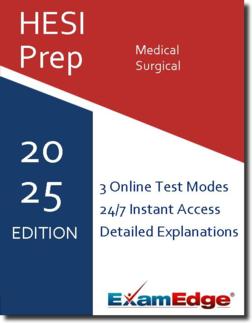HESI Medical-Surgical (HesiMedSurg) Practice Tests & Test Prep by Exam Edge - Topics
Based on 29 Reviews
- Real Exam Simulation: Timed questions and matching content build comfort for your HESI Medical Surgical test day.
- Instant, 24/7 Access: Web-based HESI Medical Surgical practice exams with no software needed.
- Clear Explanations: Step-by-step answers and explanations for your HESI exam to strengthen understanding.
- Boosted Confidence: Reduces anxiety and improves test-taking skills to ace your HESI Medical Surgical (MedSurg).

Understanding the exact breakdown of the HESI Medical Surgical test will help you know what to expect and how to most effectively prepare. The HESI Medical Surgical has multiple-choice questions The exam will be broken down into the sections below:
| HESI Medical Surgical Exam Blueprint | ||
|---|---|---|
| Domain Name | % | Number of Questions |
| Diagnostic and patient monitoring function | 24-26% | 26 |
| Administering/monitoring therapeutic interventions | 24-26% | 26 |
| Helping role | 16-18% | 17 |
| Teaching/coaching function | 16-18% | 17 |
| Effective management of rapidly changing situations | 9-11% | 10 |
| Monitoring and ensuring quality of health care practices | 2-4% | 2 |
| Organizational and work-role competencies | 2-4% | 2 |


